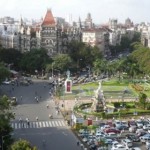Spanish apparel brand Zara unveiled its flagship store last month in the 110-year-old Ismail Building at Mumbai’s Flora Fountain Circle, that anchors the west axis of Mumbai’s old financial district. Here was another extraordinary example of a heritage space having been reimagined for contemporary use, akin to the revival of adjoining heritage areas in the city, such as Ballard Estate, Dadabhai Naoroji (D.N.) Road, Chhatrapati Shivaji Terminus (Victoria Terminus station) and the Brihan Mumbai Municipal Corporation headquarters, Crawford Market, and Opera House. This prompted Gateway House to co-host a discussion on how foreign brands are helping rethink heritage conservation.
The panellists spoke of three main concerns: first, there is an urgency to preserving Mumbai’s built and natural heritage as the Maharashtra government has targeted 2020 as the year for inaugurating Mumbai’s international financial centre at Bandra-Kurla Complex. The city’s rich political, economic, maritime and cultural history, albeit a colonial one, has to be integral to the inevitable infrastructural (Coastal Road, Metro) and other changes overtaking it. Leading cities, such as London, New York, Paris, and soon Shanghai (whose international financial centre will open in 2019) have used their heritage precincts to highlight their global financial legacy.
Change and reuse
Second, with the shift by big banks, companies and businesses from south Mumbai’s old banking-shipping-insurance-financial hubs to newer business districts, like Bandra-Kurla Complex, Lower Parel and Andheri, many beautiful old buildings on D.N. Road and Ballard Estate, for example, are now empty, mired in family disputes or hemmed in by low rents. Reinventing their original purpose in a contemporary context has worked well: the Army & Navy Building, which today houses the West Side store, was once the Army & Navy Store. Derelict spaces are also serving as artists’ ateliers and hip, edgy co-working spaces, like the Ministry of New, that opened in 2016 at Kitab Mahal on D.N. Road.
Numerous designer stores, art galleries, cafés in the Kala Ghoda precinct, and the two international luxury brands, Hermés and Christian Louboutin, chose the Old Bombay Green (Horniman Circle) as location for their stores over the security of a mall or five-star hotel. The panellists pointed out that high-end luxury brands have usually chosen to associate with heritage buildings and streetscapes– Oxford Street, London, and Place Vendôme, Paris, offer comparison–as history, continuity and reinvention are values they themselves endorse. This can become a trend in Mumbai, which is home to the largest number of billionaires in India, a consular hub, and therefore draws a sizeable expat community
Third, heritage spaces serve as wonderful venues for cultural festivals, such as the erstwhile Banganga Music Festival, and the Kala Ghoda Arts Festival (KGAF), whose model of Public-Private-Partnerships (PPP) between NGOs, civic authorities, and corporate sponsors has been successful. Some efforts, though, have been wholly due to the passion of private funders, conservation architects and cultural curators, like the restoration of Mumbai’s Opera House.
Some interesting outcomes of this discussion were:
- sensitisation of stakeholders to the heritage spaces they occupy, as in the on-going restoration at Crawford Market;
- the passing of a government resolution (GR) to institutionalise coordination between the various parties, as in the case of the KGAF;
- use of the PPP model in restoration: a large part of the funding for the old Town Hall project came from government;
- engaging the Indian Navy to showcase its heritage naval dockyards and awakening citizens to the maritime and naval history in their midst.
To tie this together, there has to be a vision for Mumbai 2020 that promotes the city’s built and natural heritage as its Unique Selling Point.
Gateway House and Avid Learning co-hosted a discussion on ‘Revitalising Mumbai’s Historic Precincts: are Foreign Brands the Catalyst?’ on June 14. The panellists were: Harish Bhat, brand custodian, Tata Group; Anita Garware, chairperson, Indian Heritage Society (Mumbai); Marlies Bloemendaal, founder and creative director, Ministry of New; and Kruti Garg, conservation architect, Abha Narain Lambah & Associates.
Sifra Lentin is the Bombay History Fellow at Gateway House.
This blog was exclusively written for Gateway House: Indian Council on Global Relations. You can read more exclusive content here.
For interview requests with the author, or for permission to republish, please contact outreach@gatewayhouse.in.
© Copyright 2017 Gateway House: Indian Council on Global Relations. All rights reserved. Any unauthorized copying or reproduction is strictly prohibited.


